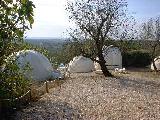 Some OAS members spent the week of 11th to 18th August 2007 at COAA, the astronomy centre in the Algarve, in southern Portugal.
Some OAS members spent the week of 11th to 18th August 2007 at COAA, the astronomy centre in the Algarve, in southern Portugal.
Visit to COAA
Seven clear nights in a row, what a treat for astronomy enthusiasts who have to put up with the unpredictable weather in the UK! That was the experience for those of us who visited COAA in May and August this year, and we had sunny days as well.
Bev and Jan own and run Centro de Observação Astronómica in the Algarve. There is accommodation for 13 guests, and four domes set up for viewing. These house a 20” reflector with an equatorial mount, a 12” Dobsonian, and two other scopes with equatorial mounts, an 8” and a 12”. Bev is an expert observer, and he organises the viewing, taking account of discussions over dinner about what guests would like to see. The August group did most of their observing using the 20” telescope. Bev had to be very energetic, rotating the dome manually, and manhandling the telescope to find deep sky objects. The scope tracks, but does not have a GoTo. Notable objects we observed were the nova in Vulpecula, the Veil Nebula (NGC 6995), the Blinking Nebula (NGC 6826), globular clusters M5 and M80, as well as galaxies, double stars and red variables. Owing to the size of the telescope, on occasions we had to climb up a step ladder to be able to see through the eyepiece. The August group did not include any experienced astrophotographers, but Bev took us through the process using a digital SLR camera and the 20” telescope. The images were a group effort: Bev located the objects and set up the camera. We took turns to start and stop the imaging, time the exposures and guide the telescope. For myself as a novice, guiding the scope manually helped me understand the principles. We had to keep the guide star in position within a small square in the eyepiece by using buttons to move the telescope up, down, right and left. It was a relief when the resulting images had stars as points of light, rather than streaks. We took images of M13, The Blue Snowball Nebula (NGC 7662), the Cat’s Eye Nebula (NGC 6543) and various other deep sky objects. The ‘star’ of the show was an image of Neptune and Triton. Visual and binocular observing was good. Jeff recorded a limiting visual magnitude of 5.75. The Double Cluster in Perseus, M4, M22 and M28 all stood out well with binoculars, with Alpha Librae and Nu Draconis easy to split. The hospitality at COAA was excellent. Jan, Bev’s wife, does all the cooking, and we were extremely well fed. Jan has good local knowledge and advises on excursions (she will phone up and book as well), and will also organise taxis and car hire. There was plenty to do during the day: dolphin watching, river excursions, and flights in light aircraft (Mike has tales to tell about that!). The beaches are beautiful, and there is plenty of varied countryside to explore. Carole and her husband are keen birdwatchers, and their patience was rewarded with a good sighting of hoopoes, the first time they had seen them in the wild. Thanks to Delphine who recommended COAA, having visited previously. She also organised all the bookings, flights, taxis and car hire for those of us who went in August. Some of us have even been inspired to try out astrophotography for ourselves.

